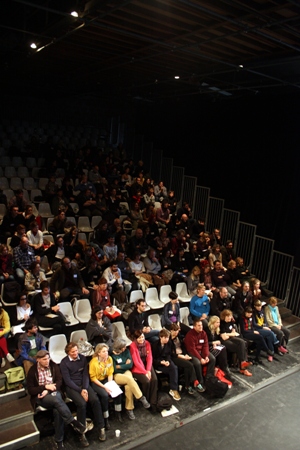DISCUSSION WORKSHOP - COLLABORATIVE EVENTS & PROCESSES
How to involve inhabitants and local actors in the creation process or in creative dialogue ? The detailed presentations of a collaborative video street show lead by Komplexkapharnaum group and a carnival in Belfast have launched the debate.

â–ºBRIEF SUMMARY
For most of their productions, Komplexkapharnaum claim the same approach : start on without knowing the destination, suggest inhabitants a dream with the aim to share the project along his definition, use a diplomatic way with the local leaders (avoid and respect their leadership in the same time, they have got the time and the key to spread audience). And beyond audience success or not, endeavour to leave a trace, a new perception of local realities.
 How to build a common future after civil war time ? The Belfast’s organization Beat Inititiative had its idea : make people working together and invest the city center which was considered as a dangerous area, stuck between catholic and protestant districts. With a first edition in 1995, the Belfast Carnival has won since its bet to create a new picture of the city, former opposite populations share now the same public space in a friendly way. However with the success, initial creativity and liberty become harder to maintain. Sleeping partners wait for big shows, tourism requirements transforms relationships with the city councils.
How to build a common future after civil war time ? The Belfast’s organization Beat Inititiative had its idea : make people working together and invest the city center which was considered as a dangerous area, stuck between catholic and protestant districts. With a first edition in 1995, the Belfast Carnival has won since its bet to create a new picture of the city, former opposite populations share now the same public space in a friendly way. However with the success, initial creativity and liberty become harder to maintain. Sleeping partners wait for big shows, tourism requirements transforms relationships with the city councils.
Komplexkapharnaum meet the same kind of questions. Their performances are usually requested by municipalities through social and cultural programs for rough districts. Towns look for media impact and large audience first. Who is in charge to go with the even slice effects of their work once they left ? In its case of an exertion at the same place all year long, Beat Initiative think they have not been working enough with their supporters, just focusing on artists and public. But both underline one rule. Always begin by asking its interlocutors : have we something to share together ?
And one skill as well : the ability to negotiate.
Despite the fact this two examples illustrating collaborative events pertain to the only category of street performances with the ease of occupying public space, common methods and teachings are able to be drawn for all practices.
![]() Be clear with interlocutors, producer, sleeping partners, public and yourself : do we have something to share, to celebrate, to say, to change together ? What is the common aim ? Who ask for ? Who has got the ownership of the idea ?
Be clear with interlocutors, producer, sleeping partners, public and yourself : do we have something to share, to celebrate, to say, to change together ? What is the common aim ? Who ask for ? Who has got the ownership of the idea ?
![]() Who is concerned first in the collaborative process : artists, citizens, whole city, neighborhood, local cultures, visitors or foreigners, children, all of them ? Which level of participation for each from the definition of the process to the assessment.
Who is concerned first in the collaborative process : artists, citizens, whole city, neighborhood, local cultures, visitors or foreigners, children, all of them ? Which level of participation for each from the definition of the process to the assessment.
![]() Think about all networks and methods to explain your approach and to improve participation, from door to door to social networking services. Pay a special attention to local groups, associations and community leaders. How to involve them and to manage them ?
Think about all networks and methods to explain your approach and to improve participation, from door to door to social networking services. Pay a special attention to local groups, associations and community leaders. How to involve them and to manage them ?
Over all, do not forget the main thing is not the event but how that happen. Further than a common experience, an artistic approach with a collaborative way appears as the most efficient way to produce new ideas, to change routine, to overcome resistances and crisis situations, to prompt social change, to create new balances towards a sustainable development. Identities are the raw materials. The central point is a question of governance. People empowerment is the name of the game. It transforms the role of the artist. He has not to just make its play anymore, but to find the right artefact for people and accompany them towards creative outburst.
Afterthoughts about practices from the digital world, UNESCO Universal Declaration on Cultural Diversity, an interview of a theoretician on cultural policies, and a manifesto extend the debate.
José Darroquy
Text written on the basis of discussions in Bordeaux on 28/10/2011 during the workshop on “Collaborative events & processesâ€
Coordination Trans Europe Halles and ARTfactories/AUtre(s)pARTs




